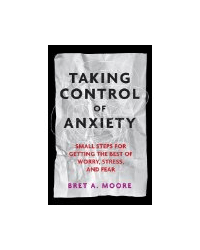“Taking Control of Anxiety: Small Steps for Getting the Best of Worry, Stress, and Fear”

“Taking Control of Anxiety: Small Steps for Getting the Best of Worry, Stress, and Fear”
By Bret A. Moore
American Psychological Association
Washington, DC, 2014
Book emphasizes practical application
Reviewed by James K. Luiselli, Ed.D., ABPP, BCBA-D
The market for psychology self-help books continues to flourish. Unfortunately, many books in this genre are of dubious quality, lack evidence support and leave the reader with more questions than answers. Fortunately, “Taking Control of Anxiety” by psychologist Bret A. Moore is a breath of fresh air, wonderfully conceived and likely to benefit many individuals who are concerned about worry, stress and fear in their lives.
The book focuses exclusively on adults, in Moore’s words, “to provide you with practical information, advice, and strategies for managing your anxiety.” He advises the reader to consider each of the 10 chapters in the book but, if necessary, to pick topics that are of greatest interest. Emphasizing practical application, Moore writes: “Keep this book on your nightstand or kitchen table or in your work bag or back pack. This is a tool for your life, not something to read once and shelve for ever after.”
The many strategies and recommendations contained in the book emanate from a cognitive-behavioral treatment perspective stressing deliberate confrontation of distorted thinking, performing “behavioral experiments” to test the veracity of irrational beliefs and facing anxiety issues head-on with a systematic intervention plan.
The book also rests heavily on Problem Solving Therapy as a dominant therapeutic modality. In this vein, the reader is guided to define personal conflicts, consider behavior-change alternatives, make a choice and assess the outcome.
Several chapters in the book address other CBT-related approaches, specifically mindfulness, behavioral activation, exposure and controlled breathing-imagery-progressive muscle relaxation. A chapter on the salutary effects from routine exercise is also noteworthy. The pragmatic emphasis of these and other chapters is most appealing: Moore presents the relevant background information, tells the reader what to do and suggests procedural options to apply under unique circumstances.
All of the techniques described in the book demand empirical validation in order to determine if they were successful, was it necessary to change anything and did the results match expectations? Some readers may be surprised about these responsibilities but Moore explains convincingly the rationale for data documentation. He further offers numerous checklists and recording forms to assist with carrying out the respective methods.
Among other “user-friendly” features, the book lists Internet Web sites for accessing downloadable documents and Smartphone applications that cover a host of issues related to anxiety management and control. Moore also included a very useful chapter for seeking professional help and the role of common anti-anxiety medications. Finally, the book concludes with a list of 52 anxiety relief activities which the reader is encouraged to try and verify effectiveness on a 10-point evaluative scale.
I cannot say enough good things about this book! It is unquestionably one of the best self-help resources I have come across – comprehensive, fully informed by the best contemporary research and action-oriented on every page. Psychologists and other mental health practitioners should surely suggest the book to clients pursuing anxiety treatment. As well, the book is a terrific reference for professionals in building an integrated psychotherapeutic practice devoted to anxiety disorders. In an attractive paperback format, reasonably priced and a model of clarity, “Taking Control of Anxiety” really hits the mark on every level.
James K. Luiselli, Ed.D., ABPP, BCBA-D, is Chief Clinical Officer, Clinical Solutions, Inc. and North East Educational and Developmental Support Center, Tewksbury, Mass..
Learn more about the book: Taking Control of Anxiety: Small Steps for Getting the Best of Worry, Stress, and Fear (APA Lifetools: Books for the General Public)

June 11th, 2015 at 5:34 pm David Johnson PsyD posted:
David Johnson PsyD posted:
I look forward to recommending this book to my clients.